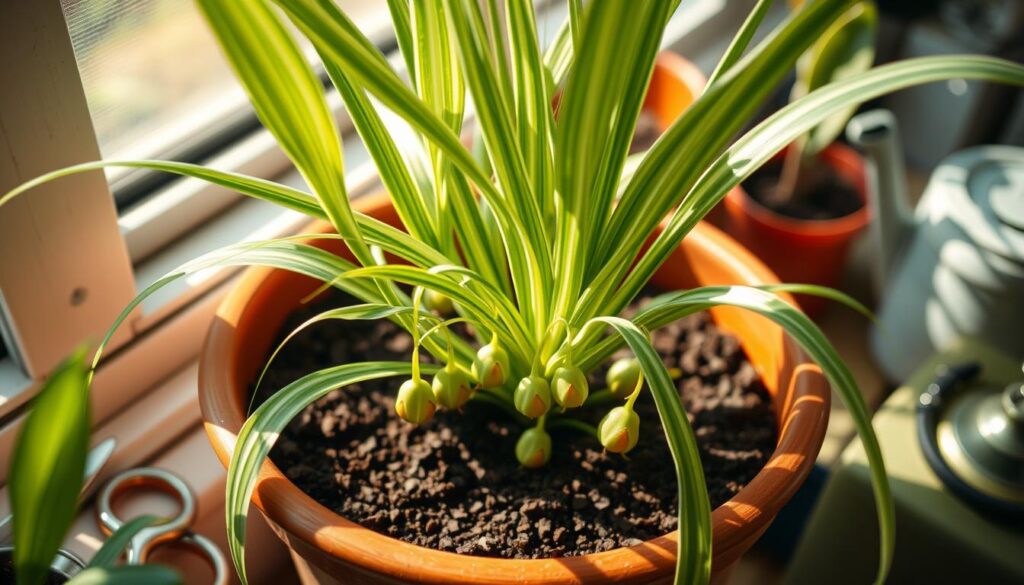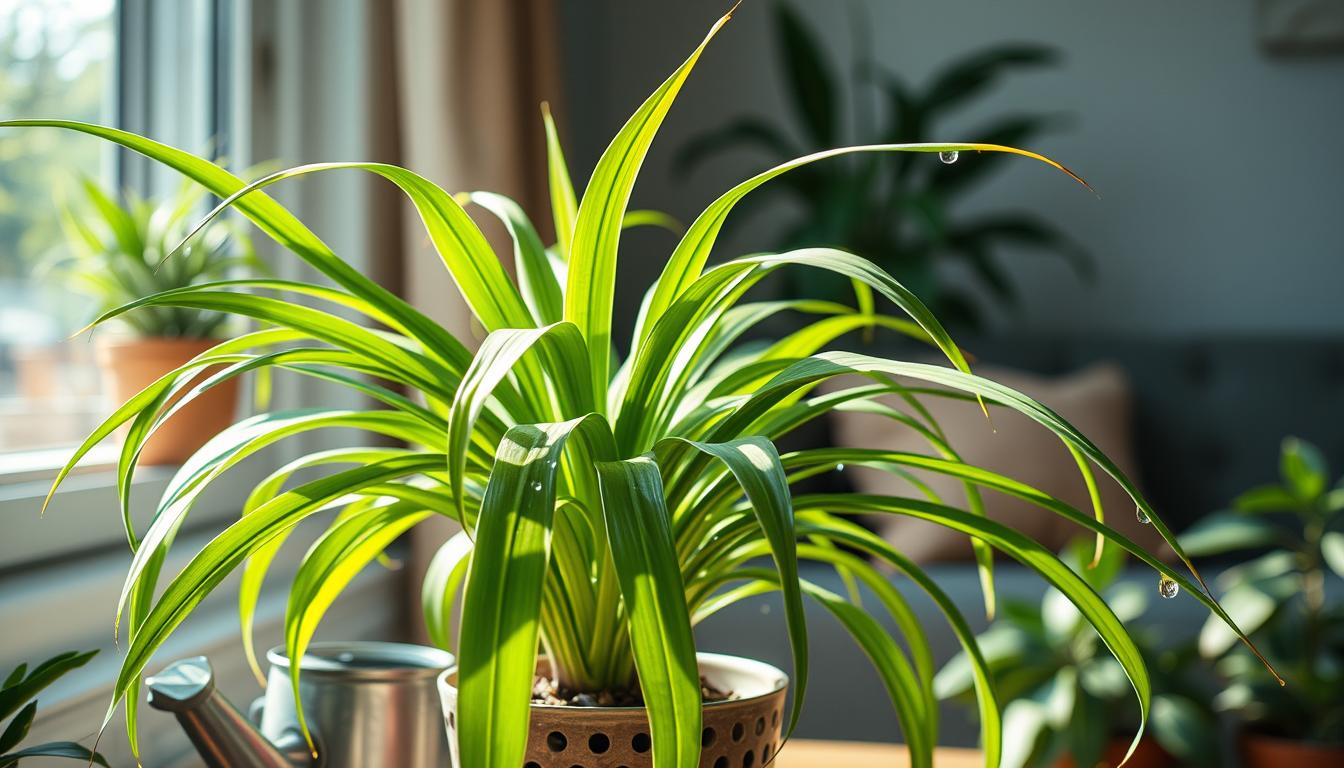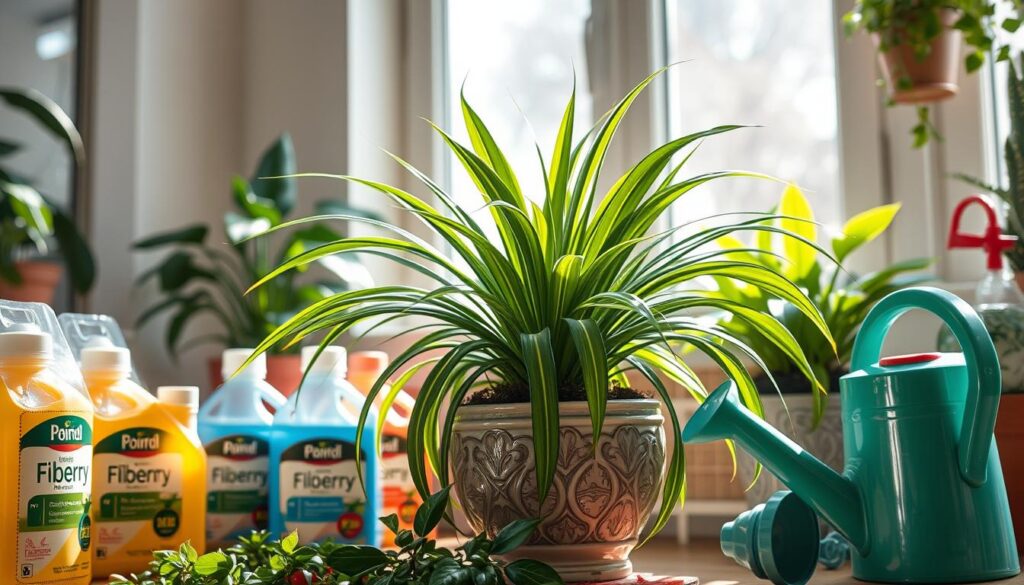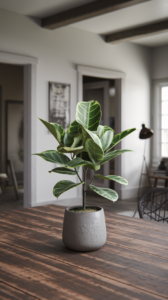Ready to learn about Spider Plant care? These plants are easy to care for and clean the air. They’re perfect for homes, making them bright and welcoming.
Spider Plants are safe for pets and kids. They can grow up to 50 cm tall and do well in medium light. Our guide will help you care for your Spider Plant, ensuring it stays healthy.
Our guide is for everyone, whether you’re new to plants or have lots of experience. We’ll cover watering and light needs, so your Spider Plant thrives. With proper care, your Spider Plant will grow beautifully, bringing joy to your home for years.
Why Choose a Spider Plant for Your Home?
Choosing a houseplant is important. You want one that’s easy to care for and good for your home. Spider Plants are a top pick for many reasons.
They are known for their air-purifying properties. This makes them great for indoor spaces. They help remove harmful toxins and pollutants from the air.
Spider Plants are also low maintenance. They do well in medium to bright light. They can even survive with infrequent watering. This makes them perfect for busy people or those new to plants.
If you’re looking for tips on Spider Plant care or want to learn how to propagate Spider Plants, you’re in the right place.
Some common benefits of Spider Plants include:
* Easy to care for
* Air-purifying properties
* Low maintenance
* Can thrive in a variety of conditions
* Spider Plant common problems are rare, but can include pests or diseases if not properly cared for.
Spider Plants are loved for their unique look and many benefits. They are a great choice for your home, whether you’re a seasoned plant owner or just starting out.
Understanding Your Spider Plant’s Needs
To keep your Spider Plant happy, you need to know its basic needs. They love bright, indirect light. This is why they do well in rooms with east- or west-facing windows.
They also need loamy soil that drains well and has a neutral pH. This is key for their health.
Watering is important. Water your Spider Plant once a week. Check if the top two inches of soil are dry before watering.
In winter, they might need less water. This is because the air is drier.
- Give them 4 to 6 hours of bright, indirect light daily.
- Water once a week, or when the top two inches of soil feel dry.
- Use well-draining soil with a neutral pH.
- Keep the temperature between 60°F to 80°F.
By following these tips, your Spider Plant will thrive. They are great for cleaning the air and look unique too.
How to Properly Pot Your Spider Plant
Choosing the right pot and soil is key for your Spider Plant’s health. Pick a pot that’s a bit bigger than the plant’s roots. This lets the plant grow and drain water well. Spider Plants like soil that drains water fast to avoid root rot.
For your Spider Plant’s soil, aim for a pH of 6 to 7. Use a good potting mix like Plantura Organic All Purpose Compost. It has a pH of 5 to 7. Also, pick a balanced fertilizer to help your plant grow strong.
Here are some tips for potting your Spider Plant:
- Choose a pot that’s only 1-2cm bigger than the old one.
- Repot when the roots show and the plant grows out of the pot.
- Water every 1-2 weeks, based on humidity and temperature.
Follow these tips to make your Spider Plant happy and healthy. It will add joy and freshness to your home.
| Soil Preference | pH Value | Fertilizer |
|---|---|---|
| Well-draining potting mix | 6-7 | Balanced, water-soluble fertilizer |
Fertilizing Your Spider Plant for Optimal Growth
Caring for your Spider Plant means fertilizing it often. This is key for healthy growth. Use a best fertilizers for Spider Plants with a 20-20-20 N-P-K ratio.
Remember, too much fertilizer is bad. Fertilize every 2 weeks. Use a water-soluble fertilizer. Also, follow Spider Plant watering tips to avoid overwatering.
Here are some tips for fertilizing your Spider Plant:
- Use a balanced, water-soluble fertilizer
- Fertilize every 2 weeks during the growing season
- Avoid overfertilization, as it can lead to more issues than underfeeding
Follow these tips and use the right fertilizers. Your Spider Plant will thrive. Watch how it reacts to fertilizers and adjust as needed.
| Fertilizer Type | N-P-K Ratio | Frequency of Application |
|---|---|---|
| Balanced, water-soluble fertilizer | 20-20-20 | Every 2 weeks |
Common Pests and Problems
When you care for your Spider Plant, watch out for pests and problems. Checking your plant often helps find issues early. This can stop pests and diseases from taking over.
Some pests that might bother your Spider Plant are aphids, mealybugs, whiteflies, and spider mites. These pests can harm the leaves and roots. This can make leaves turn yellow or brown.
For example, Spider Plant common problems like spider mites can make leaves look like they have polka dots. This is because they suck the sap from the leaves.
To keep your plant safe, take good care of it. This means watering right and feeding it well. A Spider Plant pruning guide can also help keep pests away.
- Water only when the soil is dry.
- Fertilize every 2 to 4 weeks when it’s growing.
- Give it bright, indirect sunlight.
- Keep it in a humid place, like a bathroom.
By following these tips, you can keep pests away from your Spider Plant. Always check your plant for pests or diseases. If you see any, act fast. With the right care, your Spider Plant will stay healthy and happy.
Propagating Your Spider Plant
Want to share your Spider Plant with others or grow more for your home? Propagating your Spider Plant is easy. You can do it by dividing the plant or using offsets and baby plants. First, learn how to care for your Spider Plant, including watering tips, to help your new plants grow well.
Dividing the plant is a common way to propagate. You split the plant into sections with their own roots and plant them separately. You can also use offsets and baby plants. These can be rooted in soil or water. Propagating Spider Plants works about 90% of the time, making it a fun and rewarding task.

To make sure your plants grow well, follow some important care tips. Keep the soil a bit moist but not too wet. Make sure they get plenty of indirect light. Water them regularly but don’t overdo it, as too much water can cause root rot. By following these tips and learning how to propagate, you’ll have a beautiful Spider Plant collection soon.
Here are some important things to remember when propagating Spider Plants:
- Spiderettes (spider plant babies) root easily with a success rate of approximately 90% when propagated in either soil or water.
- Propagation using potting soil is reported to be the most efficient method, taking approximately 1-2 weeks for spiderettes to root adequately.
- Regular watering is necessary at least once a week, particularly less frequent during fall and winter months.
By learning how to propagate Spider Plants and following these care tips, you’ll enjoy their beauty and benefits. Whether you’re new to gardening or have experience, growing Spider Plants is a wonderful way to share your love for plants and decorate your home.
Spider Plant Pruning Tips
Pruning your Spider Plant is key to keeping it healthy and looking good. A good Spider Plant pruning guide helps a lot. Regular pruning stops your plant from getting too long and messy.
In winter, pruning is even more important for your Spider Plant. It helps the plant save energy and stay alive. Prune in spring or summer to make it grow new leaves and stay open.
Here are some tips for pruning your Spider Plant:
- Use clean, sharp tools to prevent spreading diseases
- Remove any dead or damaged leaves or stems
- Cut back long stems to encourage new growth
- Prune your Spider Plant during the spring or summer seasons
By following these tips and using a Spider Plant pruning guide, your plant will stay healthy. Don’t forget to water and fertilize it too. This way, your plant will get the best care.
With regular pruning and the right care, your Spider Plant will grow and look great. It will be a beautiful, easy-to-care-for houseplant.
| Pruning Tips | Benefits |
|---|---|
| Remove dead or damaged leaves | Prevents disease and encourages new growth |
| Cut back long stems | Encourages new growth and prevents legginess |
| Prune during spring or summer | Encourages new growth and prevents disease |
Displaying Your Spider Plant
Find a bright, indirect light spot for your Spider Plant. This helps it grow well and clean the air. Remember, the right place is key, especially in winter.
Water your Spider Plant when the top inch of soil is dry. Don’t overwater to avoid root rot. With care, your Spider Plant will be beautiful in your home.
- Hanging baskets: Showcase your Spider Plant’s trailing stems and leaves in a beautiful hanging basket.
- Plant stands: Elevate your Spider Plant on a decorative stand to add visual interest to any room.
- Shelves: Place your Spider Plant on a shelf or mantle to create a stunning display of greenery.
Follow these tips to make your Spider Plant a beautiful part of your home. It will look great and help the air quality.
Bonus Tips for Thriving Spider Plants
Keep changing how you care for your spider plant with the seasons. In winter, water less and don’t over-fertilize to avoid root rot. But, in spring and summer, water more and fertilize to help it grow strong.
Watch out for any spider plant care challenges and fix them fast. This will keep your plant happy and healthy.
Follow these tips and the advice in this article. You’ll grow a strong, green spider plant. It will make your home air cleaner and more beautiful. With care, your spider plant will grow lots of leaves and baby plants for many years.






Pingback: 12 Best Houseplants for Beginners to Brighten Your Home - Trusted House Plant Guide
Pingback: "What Are the Best Low Light Indoor Plants? Discover 10 Perfect Varieties. - Trusted House Plant Guide